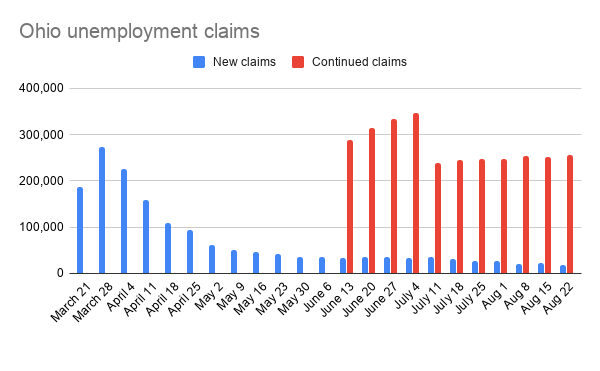New Ohio Unemployment Claims Drop Below 20K for 1st Time during Pandemic
YOUNGSTOWN, Ohio – The number of weekly new unemployment claims in Ohio dropped below 20,000 for the first time since the coronavirus pandemic arrived in Ohio.
The Ohio Department of Job and Family Services reports 18,988 initial jobless claims were filed in the week ended Aug. 22, as well as 344,409 continued claims.
Over the past 23 weeks, Job and Family Services has disbursed $6.1 billion to 790,000 claimants. In addition, the department has issued $5.3 million in pandemic unemployment assistance payments to 542,000 Ohioans. Of the 1.3 million jobless applications received, 94% have been processed.
In Pennsylvania, the state’s Department of Labor reports that for the week ended Aug. 15, 25,584 unemployment claims were filed. Since March 15, the state has received 2,025,720 claims and paid $4.7 billion in unemployment compensation and $4.5 billion of pandemic unemployment assistance.
Nationwide, 1.1 million people filed new applications for unemployment. Since the pandemic began, the weekly total of initial claims has been above 1 million every week except one.

More than 14.5 million are collecting traditional jobless benefits — up from 1.7 million a year ago — a sign that many American families are depending on unemployment checks to keep them afloat.
Until July 31, the unemployed were receiving an extra $600 a week in federal money on top of regular state unemployment benefits, part of an extraordinary lifeline extended to help them through the crisis. The loss of that money is putting the squeeze on many families.
“My income is basically cut in half,” said Taylor Love, 34, an unemployed massage therapist in Austin, Texas. “Paying our mortgage is going to be a struggle. We’re going to have to dip into what little savings we have.”
After passing a massive financial rescue package in March, congressional Republicans and Democrats have been unable to agree on more aid. President Donald Trump signed an executive order Aug. 8 offering a stripped-down version of the expanded unemployment benefits. At least 39 states have accepted or said that they would apply for federal grants that let them increase weekly benefits by $300 or $400.
Last week, nearly 608,000 people applied for jobless aid under a new program that extends eligibility for the first time to self-employed and gig workers, up from 525,000 the previous week. That figure isn’t adjusted for seasonal trends, so it’s reported separately.
Altogether, the Labor Department said that 27 million people are receiving some form of unemployment benefits, though the figure may be inflated by double-counting by states.
The pandemic has had a devastating impact on the American economy. Businesses closed and Americans stayed home to avoid infection. Economic activity plummeted. From April through June, gross domestic product — the broadest measure of economic output — shrank at an annual rate of 31.7%, by far the worst quarter on record. Employers slashed more than 22 million jobs in March and April.
Since then, the job market and the economy have been rebounding as businesses slowly reopened. Home sales and prices have been strong. Employers added nearly 9.3 million jobs in May, June and July — but that hiring surge replaced just 42% of the jobs lost in March and April.
A summertime resurgence of cases in the South and West forced many businesses to close again in July. The data firm Womply reports that business closures have mostly stabilized in the past four weeks. Still, 70% of Texas bars and 71% of California health and beauty shops were closed as of mid-August, Womply found.
Economists also worry that without additional government help the economy’s recovery will fade. “I really want Congress to come up with a benefits package,” said Jacob Hanson, an unemployed temp worker in Seattle. “Everyone needs a hand right now. The situation is pretty ridiculous.”
The Associated Press contributed to this story.
Copyright 2024 The Business Journal, Youngstown, Ohio.



